|
|
 |
Canadian Historic Sites: Occasional Papers in Archaeology and History No. 26
Grubstake to Grocery Store: Supplying the Klondike, 1897-1907
by Margaret Archibald
Swamp to Boom Town: Dawson from 1896 to 1898
It was not by accident that Dawson's founder and
first resident was an entrepreneur and speculator and that within a
month of the Klondike strike he had set up a general store and sawmill
to supply the imminent throng of goldseekers. After 13 years as a Yukon
River trader, Joseph Ladue realized that the most reliable way to profit
from a placer camp was to provide it with the essential services of food
and shelter. He had spent his Yukon days doing just that, first under
the banner of the AC Company and later in an independent partnership
with the veteran trader Arthur Harper at Sixty Mile (or Ogilvie) about
100 miles south of Forty Mile on the Yukon River.
It was from this establishment at Sixty Mile that
Harper and Ladue had grubstaked Bob Henderson, the seasoned Nova Scotian
prospector, who reputedly recommended to George Washington Carmacks and
his party to try what was to be the richest creek of the Yukon valley,
and who subsequently lost out himself. In 1896, having prospected for
two years along the Indian River, Henderson was working a creek which
issued from the same height of land (or dome) as did Gold Bottom and its
famous tributary, Bonanza Creek, known before the strike as Rabbit
Creek. It was on the latter that Carmacks, Skookum Jim and Tagish
Charlie, on Henderson's recommendation, panned out the gold which was to
give rise to the Klondike stampede. The story goes that, contrary to
prospecting ethics, Henderson was not immediately informed of the
strike. Unaware until the best claims had already been staked on the
creeks which lay over the watershed, Henderson never did become a rich
man. Yukoners consider him to be something of a tragic figure.
Ladue, who had been a prospector himself, had been
known to sit tight while others "rushed," impelled by the news of
promising new finds. His years of stampeding experience had gained him a
prospector's wisdom, if not the concommittant wealth.1 It was
perhaps less his experience than his mercenary instincts which moved him
to act quickly on this most recent strike. He hurried downriver to Forty
Mile to stake his own claim — though not on any part of the
gold-bearing creekbeds. Sensing the magnitude of Carmack's discovery,
Ladue intended to outstrip the entrepreneurs by laying claim to the only
land in the area which could serve as a possible townsite, 160 acres of
swampy flats at the confluence of the Klondike and Yukon rivers some 10
miles from Carmack's claim. There is a story that, on his downriver trip
to Forty Mile, Ladue met a Klondike-bound miner asking for lumber.
Figuring that prices for timber would soon surpass anything yet seen in
the Yukon, he immediately dismantled the Sixty Mile sawmill and shipped
it, together with all the dressed lumber he could find, down the Yukon
to the new townsite.2
By 1 September, a mere two weeks after the discovery,
the 160-acre townsite had been patented and was ready for
survey.3 The sawmill was reassembled immediately so that
building materials would be available before winter set in, and a
two-storey cabin was erected to serve as trading post and saloon. On
what was known simply as Joe Ladue's townsite, these were the first
stirrings of enterprise and civilization.
Although news of the Klondike strike spread like
wildfire inside the territory that fall, the secret was kept well from
the outside world. By January there were only four cabins beside Ladue's
on the townsite. As spring came, eight more sprang up, surrounded by a
collection of bedraggled canvas dwellings which increased
daily.4 It was not until 2 June that the AC Company steamer
Alice slid around the Moosehide bend.5 As the first
steamer to reach the Klondike that year, she was to carry out with her
the men whose arrival in San Francisco a month later was to trigger a
worldwide scramble for Klondike gold. Among these men was Joseph Ladue.
After spending half of his 43 years crossing the continent in search of
his particular paystreak, Ladue had finally found it. He named his 160
acres of paydirt Dawson City, after George Dawson, the Canadian
government geologist who had studied the territory in 1887.
There were some who, at the time, had suspected that
Ladue had fabricated a grand rumour about a minor strike in order to set
off a stampede in his region. But Dawson was no illusion, nor were the
crates of dust that accompanied Ladue and the other on the
Excelsior. While there were certainly those who thought that Joe
Ladue was not above such things, it was hardly the time to voice their
suspicions.
Before the hordes who would eventually pour into the
Yukon valley had time to drop whatever they were doing and set out "Ho!
for the Klondike!" the first steamers up the Yukon had already deposited
two influential entities at the Klondike's mouth. While they were
newcomers to Dawson, they were in a sense sourdoughs of long-standing
reputation in the Yukon valley. No one was surprised to see them among
the first arrivals. By early July, both the Alaska Commercial Company
and the North American Transportation and Trading Company had erected
stores and warehouses which became the focal point of Dawson's Front
Street. The AC Company's two-storied store (40 feet by 80 feet) upheld
the company's reputation along the Yukon for consistently putting up the
biggest building in each town. Adjacent to it were three corrugated iron
warehouses, another two-storey building which served as employees'
living quarters, and an additional warehouse. The next block had a
similar store, quarters and warehouse of the NAT&T Company.
Bearing in mind that newcomers from the outside did
not reach Dawson until the late summer of 1897, it is understandable
that the summer's commercial activity was relatively slow and stable,
carried out mainly by the two mercantile monopolies to provide for the
most recent placer congregation. Ladue himself recorded an absence of
competition. In another description of the town's business in the late
summer of 1897, there is no reference to any individual provisions
merchant.6 (Ladue was dealing almost entirely in timber.)
Prices were high, but neither inflationary nor unsteady (see Appendix
J). Ladue explained them: "In the present conditions of trade things
cannot be sold very much cheaper at a fair profit."7
The greatest problem facing the trading companies
— and a serious threat to Dawson — was the potentiality of
winter shortages and possible starvation in the new camp. During the
winter of 1896-97, for example, the North-West Mounted Police contingent
at Fort Cudahy, buying from both companies, had been forced to reduce
the basic flour ration.8 Some mines finished the winter with
flour and nothing else. Dawson itself had suffered one particular
shortage that winter, although not an acute one; there were no eggs.
(This shortage gave rise to a legend about Swiftwater Bill Gates. To
spite his unfaithful lover, Bill bought up the town's entire supply of
her favourite food, a very rare commodity, whole fresh eggs. If
Swiftwater Bill was as thorough in his retaliation as we are led to
believe, there was not an egg to be had in the entire camp.)
The situation in Dawson in 1897-98 was far different
from that experienced by the isolated community which had wintered there
the previous year. The community of 1896-97 had been made up entirely of
miners and prospectors already inside, experienced men of the north, who
knew the essential requirement of an adequate winter outfit. The local
population explosion of the late summer of 1897 (though it hardly
compares with that of 1898) was composed almost entirely of tenderfeet
from the south, men so smitten with gold fever that they had not
hesitated a moment before rushing north. Leaving on the first crest of
enthusiasm, they had neither help from published guides nor realistic
advice. They did not know how unwillingly the Yukon valley gave up its
gold, and with what ferocity its winters could punish the
improvident.
The very presence of these hasty and unprepared
arrivals was enough to dismay the head office of the AC Company. Such
impatience could easily lead to a "starvation camp," an irrevocable blot
on the company's record. As early as mid-July, the company's president,
Louis Sloss, made clear his concern to a San Francisco newspaper. For
any outfitter or steamship company to encourage a rush that season would
be both cruel and foolish. However sincere such promotion might be, it
would be responsible for the resulting deprivation in the Klondike, and
criminally responsible at that.9
Exactly how many ambitious Klondikers managed to
enter the territory before winter closed in cannot be determined. Nor is
it possible to know how many of them had winter outfits. Police
estimated that by 1 January 1898 there were almost 2,000 people in
Dawson and 5,000 in the Klondike region.10 At the beginning
of winter, starvation, or at least severe suffering, did seem likely.
Once again a dry fall lowered water levels on the shallow Yukon River,
cutting supply traffic short and prematurely ending the provision of
winter staples. By the end of September, the NAT&T Company had 400
orders yet to fill; the AC Company had received scarcely a third of its
paid consignments.11
Both companies traditionally received their stocks on
the basis of individual orders for outfits. Early in the season, the
consignee entered his name with the company and deposited half the price
of his outfit. While the two companies were faced with the same prospect
of shortage, their methods of dealing with the crisis differed. The AC
Company, which had enough material to outfit 1,252 men completely and
furnish flour to 1,589 more,12 chose to fill to the best of
its abilities all of the orders it had received. The NAT&T Company,
on the other hand, preferred to bypass its original orders and to ration
all its stocks on the basis of need.13 In October, when the
scare was at its worst, both companies were persuaded by the Mounted
Police and government authorities to fulfill their responsibility to the
worst-outfitted miners by offering transportation downriver to Fort
Yukon, where supplies were said to be more plentiful.14
Both firms did attempt to curb skyrocketing prices;
they eventually limited their sales to issues of supplies for two weeks
at a time, thereby controlling food speculation.15 Despite
their efforts, prices for flour, the most basic as well as the most
limited staple, ran wild on the black market. At midwinter the retail
price for flour seems to have ranged from $35 to $100 for a 50-pound
sack.16 Butter, when it could be had at all, was going for $5
a pound and salt for its weight in gold.17 Such prices put
these commodities beyond the reach of most buyers and turned their goods
into mere figures on the speculative market.
As winter drew to an end, it became clear that there
would be enough to go around and that Dawson would not starve after all.
Two unexpected factors relieved the situation: extra commodities were
thrown onto the market by people who left the district after freeze-up,
and those who stayed were blessed with an unusually mild winter. Indeed,
the Klondike Daily Nugget declared in comfortable retrospect
that, considering even the obvious cases of speculation and
inflation,18 the whole situation had been nothing but a
scare. Many placed the blame squarely on the two supply outlets which,
for all their protestations of innocence, were suspected of having
rigged the shortage for their own benefit. Those citizens of Circle City
who had made an orderly raid on the AC Company's steamer Bella in
the late fall were only too aware that their camp was being by-passed by
the company in order to get supplies through to Dawson, which lay
further upriver. They interpreted the company's intentions as pure greed
for the higher prices which undoubtedly prevailed at the newer camp. The
NAT&T Company suffered as much, perhaps even more so, from
accusations of unbridled favouritism in their rationing policy. The
Nugget was the community leader in its outspoken criticism of the
latter company, specifically of its manager, Captain J.J. Healy, for his
handling of the food shortage. Healy was accused of refusing to fill
some orders and then selling out such rare luxuries as molasses and
tobacco to favoured speculators at fabulous prices. Over the summer of
1898 the Nugget painted the picture in increasingly lurid
colours. The last instalment, released just before Healy was recalled by
the company in September, disclosed that the demi-mondaines and
"satellites who revolve in that particular sphere" had won Healy over,
while honest miners and small businesses had gone
short.19
Even those who denied that the situation had at any
time been out of hand could not overlook the prevalence of scurvy in
Dawson that winter. Limited and unvarying diets and poor-quality or
badly cooked food had been the cause. By breakup, bacon was the only
meat available; tinned vegetables had gone off the market early in the
season.20 Wherever the blame lay, a lesson had been learned
by both consumers and suppliers, who resolved to stock up the town's
warehouses over the coming summer. Further to ensure that the situation
would not repeat itself, the North West Mounted Police, who had kept
watch over the winter supplies, enforced a regulation made by
Commissioner Walsh that all men crossing the passes have at least 1,095
pounds of provisions to support themselves for a year's
stay.21
To everyone's relief, the winter of 1897-98
officially ended on 8 June with the arrival of the Mae West, one
of the steamers which had spent the winter locked in Yukon River
ice.22 Another good omen was the fact that her cargo included
whisky. At that point bars had been serving what amounted to
whisky-flavoured water; "thirsty" rather than "hungry" might be the best
description of the badly stocked town.
When the ice broke up and the steamers could move
freely again along the Yukon River, the news spread wide across the
continent and the great Klondike rush was on. Perhaps the most eager
were the thousands who had camped on Bennett Lake, impatiently awaiting
their chance to be among the first to grasp at the pot of gold.
Mixed in with the multitude were speculators and
entrepreneurs who had heard that Dawson was a starvation camp, that any
conceivable article could be unloaded on that desperate town at prices
unheard of in any previous placer camp. Such rumours seemed all the more
believable in conjunction with out-of-date reports which had come out of
the town the year before, before Dawson's first millionaires had left,
when there were still enough nuggets to go around. Such testimonials as
the following one, issued in June 1897 and republished later that year,
fostered the vision of Dawson as exceedingly rich and very hungry.
"There are more ways of making money here than any place I ever saw . .
. Big money can be made by bringing in a small outfit over the ice this
fall . . . I have seen gold dust until it seems almost as cheap as
sawdust."23
Since these individual businessmen were to some
extent in active competition with the already entrenched monopolies,
their greatest advantage in the battle for the market was timing.
Traditionally the first and the last boatloads of goods commanded the
best prices. There was, therefore, a rush of a specialized kind which
took place within the 5,000-craft armada in the great June boat race to
Dawson24 The goal was to be the first into town with the
goods and services which the population craved. The stakes were high,
but they were equalled by the risks involved. While the passes had the
advantage at first of being the fastest route to the Klondike (since the
Yukon's northerly mouth did not thaw for shipping until early July) the
probability of loss or spoilage over that precarious trail was
considerable. Costs were high, even though most of the traders built
their own scows. Early spring shipment by native packers from Skagway to
Bennett Lake amounted to about 12 cents a pound, and would increase when
the ice was replaced with the more treacherous spring mud.25
The chances of meeting disaster on the river were fairly good,
considering the unwieldy nature of many of the home-made craft and
scows. Miles Canyon and the Five Finger Rapids had become legendary
graves for men and merchandise, while the river's countless shoals and
sandbars were particularly hazardous in the early spring and late fall,
when the freezing of the river's tributaries lowered the water level.
The final risk concerned the market itself, the chance that it might
already be deflated by earlier arrivals. To the successful went the
spoils in the form of astronomical prices. The best-known example is
H.L. ("Cow") Miller, who sold the products of Dawson's first milk cow at
a phenomenal $30 per gallon.26 Ice cream was proportionately
$10 a glass. One dollar, the lowest negotiable sum, would buy a tin of
meat or potatoes or one piece of fruit — unless the fruit was one
of the few melons, which sold for $25 to $35.27 Two-fifty
would buy either a pound of butter or a dozen eggs, both at a fraction
of their winter values.28 Flour prices dropped dramatically
as soon as the first sack hit the wharf; the inflated market collapsed
and the price for a 50-pound sack plummetted from $50 to $12.50 to
$3.29 Tobacco, once completely off the market, had returned
to it and "Old Chum" cost 75 cents a pound and "T & B" cost $1.
Whisky was once again available at $15 per bottle (see also
Appendix J). Unquestionably, the summer of 1898 was a high point of
Dawson's commercial enterprise. Among the variegated memories of glitter
and mud, dancing girls and disappointed goldseekers, are the recurring
stories of the success and failure of enterprising individuals,
partnerships and multi-departmental companies. Like the miners they
supplied, they lived their Klondike adventure in the belief that gold
and initiative made anything possible. Yukon commercial activity was no
longer the domain of a few large companies that it had once been. Just
as the spread of the Klondike news had thrown open the goldfields to
masses of hopeful prospectors, so the field of merchandising attracted a
great number and variety of participants — large and small
enterprises, some with vast experience and others with none whatsoever.
Every miner entering the country bearing his required half-ton of goods
was a potential trader. The commercial spectrum of Dawson extends from
the large, established corporations to these individuals,
unintentionally involved, "swapping" their wares on the Dawson
waterfront.
Delving into the chaos of the Dawson marketplace that
season, one can discern certain formative trends. Certain general types
of merchant activity can be drawn from available examples. The first
type of merchandising to be considered involves the largest and most
influential mercantile interests in Dawson. These companies were able to
control all phases of the supply and distribution process, from their
purchasing agents outside, their sea coast connections at Saint Michael
and their river fleets to their storage and retail outlets in Dawson.
The first such companies to join the ranks of the existing major firms
were the Alaska Exploration Company (the AE Company) and the
Seattle-Yukon Transportation Company (the SYT Company). Based in San
Francisco and Seattle respectively, these firms announced their
candidacy before the first of their river steamers had left Saint
Michael bearing hundreds of tons of provisions, along with materials for
corrugated iron warehouses, stores and winter quarters.30 By
the end of August, notice of complete stocks in their warehouses
appeared in the Nugget.31 In the case of the SYT
Company, the mayor of Seattle, W.D. Wood, had resigned his post to come
north and personally manage the firm.32
On a smaller scale, but still in control of all
aspects of the trade, was the California-Yukon Trading Company. With the
arrival of her steamer Rideout proudly bearing 500 tons of
freight for the camp, construction was begun on warehouses and
wharves.33 From Vancouver emerged the British American
Corporation, a transportation company running two river steamers, which
in September bought out a local merchant and opened a store and
warehouses in Klondike City, the community across the Klondike River
from Dawson.34 Another well-known firm (though without a
river fleet of its own) was the Joseph Ladue Gold Mining and Development
Company. As president and managing director of the New York-financed
firm, Ladue made his final trip to his townsite in September 1898 for
the opening of the company's store. Dawson had become everything that
Ladue could have imagined when he first laid claim to the swamp. It was
to be his last impression of the place, for he died of tuberculosis
three years later.35 His firm opened its store by advertising
goods of the best quality, adapted to Klondike use, all at reasonable
prices. "Come and examine our flour, beans, bacon, sugar, eggs, butter,
teas, coffees, spices, canned fruits, dried fruits, tobacco, candies,
clothing, underclothing, boots, shoes, stationery, etc."36
The firm retained its founder's name, and survived Ladue by almost a
decade as one of Dawson's reliable general supply firms and steam
sawmills.
There was no doubt that the NAT&T and AC
companies still controlled the bulk of Dawson's trade. Tappan Adney
maintained that of the 7,540 tons of freight brought in on the lower
river route (via Saint Michael) by 1 September 1898, half was carried by
these two companies.37 By this time, the AC Company was
running a total of 13 steamers, and had four warehouses, one of which
was exclusively for warm storage.38 Their total capacity was
5,000 tons, but four more sheds were under construction. In reporting
the growth of these two companies over the summer of 1898, the Nugget
leaned heavily toward the AC Company. The newspaper's scathing articles
led one to believe that the NAT&T Company's sales had suffered
profoundly from the discredit earned by Healy39 but his
recall eased the situation.
The success of these companies in terms of their
prominence and popularity was largely due, according to the
Nugget, to their specialized consideration of the needs of the
miner. The three-storey AC Company building, an indisputably central
point in the Dawson business area, was organized on this basis. The
first floor had rows of offices where clerks dealt with the daily tasks
of outfitting, transportation, mail, cash and credit. Nearby were 22
safety deposit boxes of case-hardened steel set in a wall of masonry and
concrete. Beyond this opened up a veritable emporium, where "countless
shelves groaning under their loads"40 of staples and luxuries
were divided into departments according to the priorities of the
miner-consumer. First came the grocery department, then hardware, china,
glassware and drugs. The second storey had mens' furnishings, combining
standard heavy-duty Klondike clothing, robes and boots with "fancy and
dress shirts, beautiful neck wear of latest designs, knox and stetson
hats in assortments equal to any shown in the avenues of New York,
Chicago or San Francisco."41 A recently opened showroom
contained a housekeeping department as well as ladies' dry goods and
clothing. The newspaperman describing the store was highly impressed
with additional and separate facilities for delivery, for ice supply,
for warm storage (with accurate checking and a 24-hour guard) and for
the assaying and storing of gold. A final revelation was the clean and
comfortably furnished employees' residence. The author's concluding
comment on such large enterprises was that their impressive
installations reflected a "faith in the permanence of the country and of
Dawson in particular as a great distribution centre."
The second group of merchants to thrive that summer
often did interdependently with these companies. Although the large
companies retailed some of their goods in yearly outfit lots, they were
in effect wholesale firms as well. Through them, individual merchants
could purchase their goods, then have them shipped, stored and delivered
for further sale. Alternatively small merchants could buy the goods
through their own outside agents, then have them shipped on vessels
usually owned by these large companies. There were, in addition, several
independent river transportation companies which catered to individuals,
merchants and companies. On the lower river route, the Columbia
Navigation Company and the Empire Transportation Company (with a fleet
of 18 steamers) operated, making connections for Seattle at Saint
Michael.42 Goods could also be shipped in via Skagway,
connecting at Bennett Lake with either the Bennett Lake and Klondike
Navigation Company or the Canadian Development Company. Before long, a
fleet of scows was also operating regularly on this upper river route,
to expedite quick delivery of small consignments.
There is an understandable lack of information about
most of the 300 "stores and saloons" recorded in the police census of
July 1898.43 Those who advertised or were mentioned in
newspaper reports leave a hazy idea of the retailing practices of
Dawson's many individual merchants. Approximately 36 retail outlets for
general merchandise, groceries, dry goods, furs, wines, liquor and
tobacco (these three usually sold together in saloons and restaurants),
jewelry, house furnishings and lumber advertised in the Klondike
Nugget Over 20 others were mentioned in articles and reports. By the
end of the season the paper was singling out several individual
merchants whose impressive stocks implied that they were in Dawson to
stay. Among them was the partnership of O'Donoghue and Swift of
Kingston, whose lines of groceries, wines, liquors and general
merchandise were proclaimed outstanding in terms of quality and
selection. Their wares apparently included many articles not otherwise
obtainable in the city.44 The Macaulay Brothers were
similarly praised for their latest styles in dry goods as well as for
their complete stock of groceries. Their shelves contained such
delicacies as jams, jellies, pickles and olives, all of which would help
"to make the Klondike life something of a pleasure."45
A third kind of merchant was the small trader who
arrived in the Yukon with his own stock all ready to sell. He brought
his goods with him; consequently he was able to act independently of the
Dawson jobbers or wholesale firms. These traders have already been
introduced as they patiently waited for spring breakup at the head of
Bennett Lake. On one Yukon River boat it was later recorded, "the
majority of the 30 passengers were going into the interior to make money
through the sale of merchandise."46 Their stocks were small
(necessarily, for those crossing the passes), but usually highly sought
after for the luxuries they included. Fresh meat, fruit and vegetables
and dairy products were the most popular cargo — items rarely
included in the miner's own outfit and both risky and expensive to ship.
Once they had scanned the market situation, these traders could return
to their outside supply bases in the hopes of freighting in another
load. A particularly profitable enterprise that summer (and for long
after) was livestock. The animals could be herded overland on the Dalton
Trail, skirting the passes from the panhandle to Fort Selkirk on the
Yukon River where the trail met the upper river steamer route. Dawson,
the herders knew, was a seller's market.
One of the best known of these independent produce
traders was R.J, Gandolfo, an Italian fruit seller, whose first shipment
of eight tons of oranges, lemons, bananas and cucumbers arrived in an
untouched market at $1 apiece.47 Paul Mizony, whose father
carried in perishable stock over the same trail, recalls:
The prices we got for some of the articles were
as follows:
| potatoes | $1.00 |
|
| onions | .75 |
|
| eggs | 2.50 |
|
| butter | 2.50 |
|
| oranges and lemons | 75.00 | a box |
| canned tongue | 1.00 | a can |
Other items like canned jams, salmon, milk,
tomatoes and meat, brought like prices. Our perishables we sold at
wholesale, the other merchandise at wholesale and retail. Most of our
stock was sold out in about a weeks [sic]
time.48
These prices are only one example, providing a very
general picture of the situation. Uncontrollable price patterns marked
most of the summer of 1898.49 As a significant element of
Dawson's waterfront, the transient produce vendors were in later years
to become the bane of general merchant establishments and their stable
market conditions.
The final group of merchants (who never thought of
themselves either as a group or as merchants) comprised an unknown
number of men who never expected to earn their Klondike gold as traders.
Many an eager goldseeker who had hauled his required half-ton outfit all
the way to Dawson discovered that, while the cost of living was every
bit as high as expected, the rich claims needed to support it were no
longer available. He rapidly concluded that his outfit must be sold to
obtain the necessary fare to return home. One outfit was good
collateral, but many men amassed a number of them and temporarily became
small retailers themselves. The familiar Dawson sign, "$15,000 money
wanted — this entire stock to be cleared out at once — prices
very low"50 demonstrates that one man could become a
commission agent of sorts for several others sharing his desire to leave
as soon as possible. Any man who was willing to speculate in provisions
in order to raise enough capital to go into mining falls into this
category as well. Jeremiah Lynch's career is an excellent example. Lynch
began by buying up the flour in a consignment of goods which the AC
Company had turned over to the Bank of British North America when the
consignee failed to pay up. Lynch managed to sell the flour for $3 a
sack less than the prevailing price. With his profit from this
transaction, he came back for other staples in the same
consignment.51
These entrepreneurs and impatient traders shared, for
the most part, a brief and disordered career in Dawson. The hectic,
bazaar-like atmosphere of their activity dominated many a first visual
impression of the city.52 The subject of a great number of
photographs, it presents a fascinating and detailed picture. Many who
arrived in small boats and scows never left the waterfront, where they
formed a "wobbly two-mile clutter from the mouth of the Klondike to
Moosehide Hill"53 (Figs. 18-19). A sand bar to the south of
the steamer landings was jammed with tents and scows so that there were
only two narrow thoroughfares to the water. Hastily constructed shelves
of planks and crates creaked with merchandise. The terms of purchase
were based on the best offer or, in many cases, on barter. Photographs
suggest that some booths specialized in certain commodities — case
lots of condensed milk, sacks of flour, boots, saws or rifles, for
example. One trader, by the look of his display, must have found argyle
socks particularly hard to sell (Fig. 20).
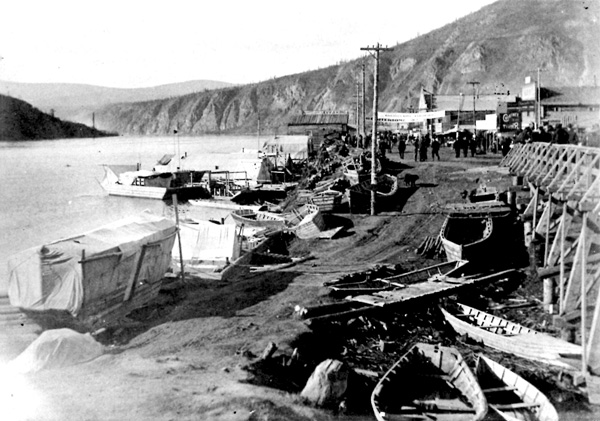
18 Scows along the Dawson waterfront.
(Public Archives Canada, PA 16182.)
|
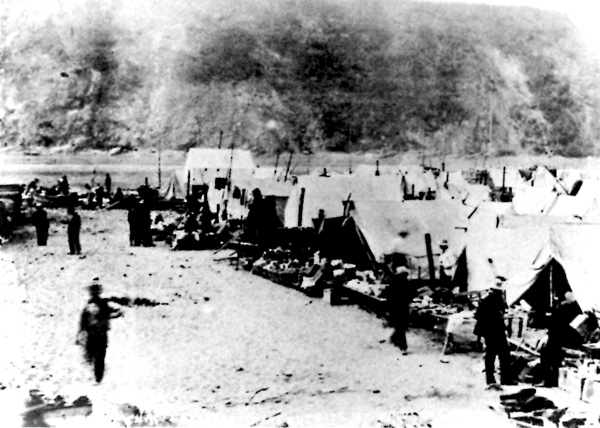
19 Cheechacos "swapping" and selling out, Dawson, 1898.
(Public Archives Canada, PA 13432.)
|
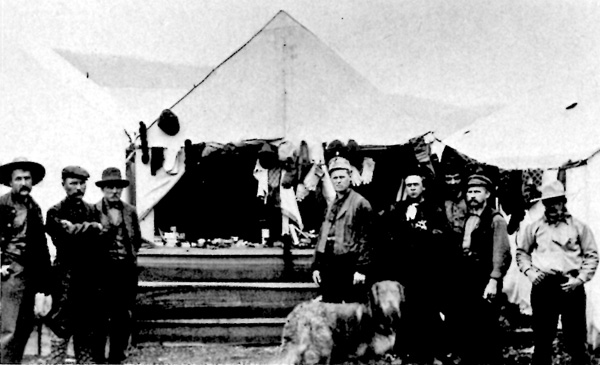
20 An early "specialist" in dry goods, Dawson, ca. 1898.
(Public Archives Canada, PA 13490.)
|
As the season wore on, those hoping to leave tried
desperately to get rid of their goods. While provisions were still
limited and high-priced, dry goods of every description glutted the
market at prices slashed to half what had been paid for them in Seattle
or Victoria. In some cases that dealer had no choice but to auction off
his stock. For a month Dawson was witness to "boots and shoes and rubber
boots and the thousand and one things we all brought with us going at
prices which would make a Clarke Street Chicago second hand man sick
with envy."54 The out-of-here-or-bust mood prevalent in the
cramped canvas quarters was further encouraged by attractive newspaper
advertisements for immediate passage outside. In one instance a group
travelling out through the NAT&T Company got special rates 50 per
cent lower than the standard rates earlier in the
season.55
While Front Street remained the city's expensive
commercial "strip," newly erected structures were gradually creeping
along the cross streets (mainly York, King, Queen and Princess) to
Second Avenue, where land was cheaper. Summer traders, who had little
capital for land or lumber but wished to operate in this central
business section, often opened simple booths — canvas-covered log
frames tucked away between two larger buildings (see Fig. 21). Gandolfo,
the fruit vendor, paid an astonishing $120 per month rent for 5 feet of
street frontage in his first quarters.56 Plate glass of any
kind was not to be had that summer, so booths and storefronts alike
opened right out onto the street or (in some parts of Front Street) onto
the sidewalk. Hooks, frames and cords were used as extensions of the
tiny interiors of such shops to hold and display all manner of crumpled
dry goods, used or warped tools and tangled tin masses of cooking
utensils (Figs. 22-26).
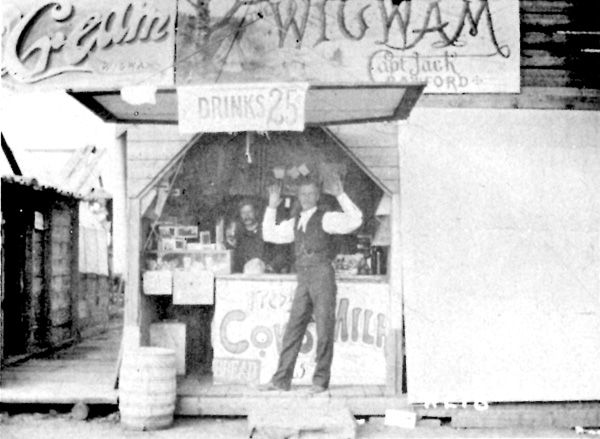
21 Captain Jack Crawford's store in Dawson, ca. 1898.
(Public Archives Canada, PA 16924.)
|
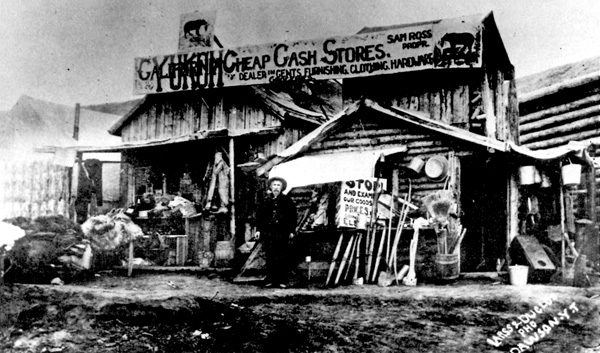
22 An early merchant, 1898 or 1899.
(Public Archives Canada, PA 13395.)
|
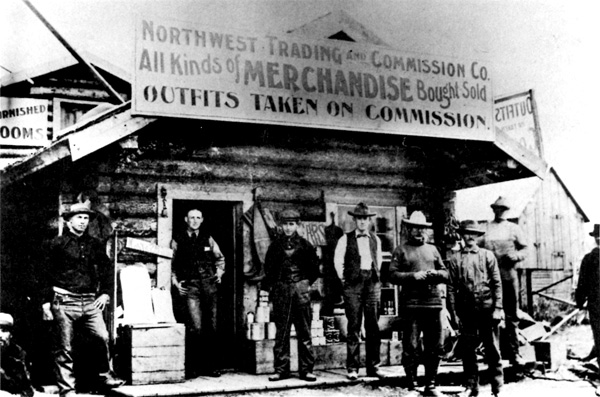
23 The Northwest Trading and Commission Company: "All kinds of
merchandise bought and sold," 1898 or 1899.
(Public Archives Canada, PA 13402.)
|
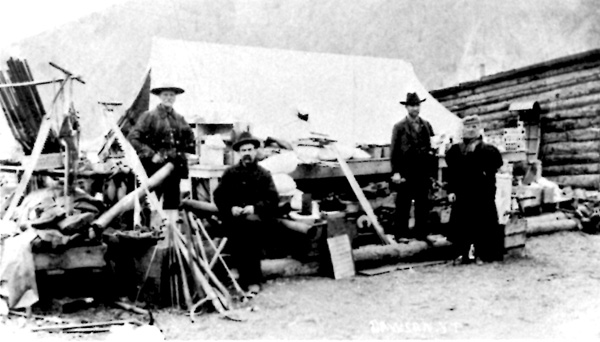
24 Reselling outfits at the Dawson waterfront, probably 1898.
(Public Archives Canada, PA 13501.)
|
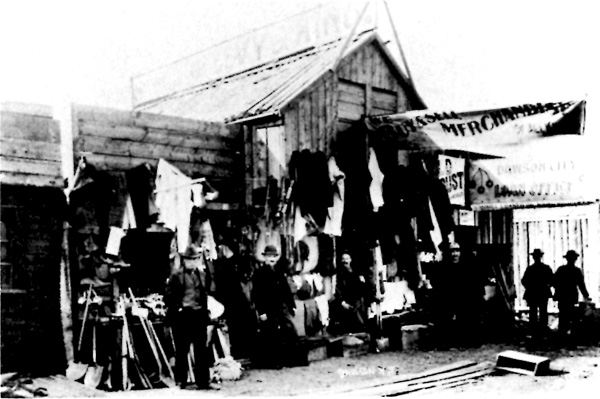
25 "We buy and sell merchandise," 1898. Ben Levy was to become one
of Dawson's better-known clothing merchants.
(Public Archives of Canada, PA 13394.)
|
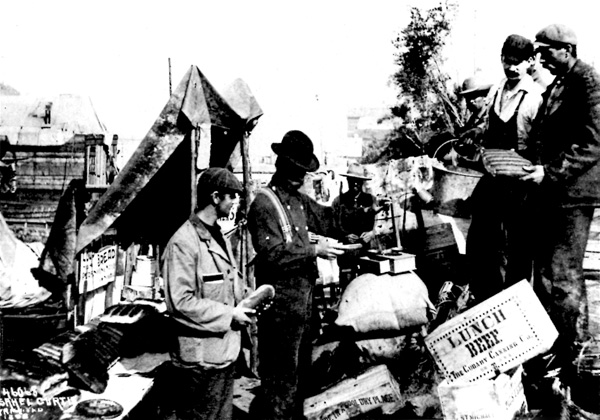
26 Selling out in Dawson, Asahel Curtis, photographer.
(Photography Collection, Special Collections, University of Washington Library.)
|
Against the dismantled Yukon stove or the sluice box
full of hip-length rubber boots leaned the proprietor. His waterstained
tent sometimes bore a hand-painted sign, or more often no sign at all
for his wares were known to all. He had lightered his own load onto the
beaches of Dyea, packed all 2,000 pounds of it over the Chilkoot, pried
it loose from the mud on the trail, and perhaps rescued it from one of
the shoals along the Yukon River, until at last he had reached the mecca
— Dawson, a muddy congestion of stumps, sawdust and dogs, populated
by innumerable cheechacos or tenderfeet like himself. This population, it
seemed, had one thought in mind: to get rid of the condensed milk and
the mackinaw suits to a luckier (or more naive) gold seeker who intended
to stay inside, and to return to the relative sanity and security of
Montreal or Seattle.
By the end of the shipping season (4 October that
year), the majority of disillusioned or homesick cheechacos had managed
to swap enough for a passage outside. Among those who had reason to
remain, there was an unquestionable confidence in the air. There would
be no talk of starvation in Dawson this fall. Well-stocked warehouses,
busy order offices and hurried autumn construction all reflected what
the Nugget termed the "faith of the moneyed men in the
Klondike."57 When Joe Ladue arrived in town late in August the
newspaper turned to him, as if for a patriarchal blessing. Ladue was
glad to oblige, and the Nugget reported that the city's founder was much
pleased with the growth and stability he saw around him.
The daily arrivals of loaded supply vessels over the
last months had allowed many a new establishment to blossom in elegant
premises. The Fairview and Aurora hotels and the Monte Carlo saloon were
known as Dawson's 'first class' establishments. For those who could
afford them, shipments of mirrors and mahogany replaced newspapered
walls and rough-hewn benches. By September two furniture stores were in
business, one offering "bed room suites, parlour, office, dining room
and saloon chairs, rockers, cobbler-seats, armchairs."58 In
addition to the already successful lumber trade, there was a burgeoning
tinware industry manufacturing pipes, fittings and, as winter drew
near, quantities of Yukon stoves. In this field McLennan and McFeely
were pioneers. They had lost no time in opening branches of their
establishment in Bennett and Dawson (Fig. 17). "Mc & Mc" was a
well-known firm in Vancouver, and this act of faith in the potential of
the district did not go unnoticed in the Dawson business community.
The two most significant features of the market at
the season's end were the greatly increased variety of available
commodities and the corresponding drop in prices.59 The price
of eggs settled at a respectable $3 a dozen, tinned fruit and vegetables
at 75 cents a can, bread at 25 cents a loaf. Tinned meat was expensive
— $2.50 a can — while potatoes were less than 50 cents a
pound, half their July price. While such prices were not necessarily
the cheapest such items had been, the arbitrary and fluctuating element
in the market had been settled.
The multitudinous Dawson restaurateurs were among the
most astute observers of market fluctuations (Fig. 27). By the end of
the season, some of the more popular restaurants were reflecting the
time-of-plenty atmosphere with extensive and elaborate menus. For the
most part, though, there was little choice in which restaurant one
frequented. One weary customer reported, "You can eat anywhere. Its all
equally bad and dear."60 The average menu card ran as
follows:
| Sandwiches | $.75 | each |
| Dough-nuts | .75 | per order |
| Pies | .75 | per cut |
| Turnovers | .75 | per order |
| Ginger cake | .75 | per cut |
| Coffee cake | 1.00 | per cut |
| Caviare sandwiches | 1.00 | each |
| Sardine sandwiches | 1.00 | each |
| Stewed fruits | .50 | per dish |
| Canned fruits | 1.00 | per order |
| Cold meats | 1.50 | per order |
| Raw Hamburg steak | 2.00 | per order |
| Chocolate or cocoa | .75 | per cup |
| Tea or coffee | .50 | per cup61 |
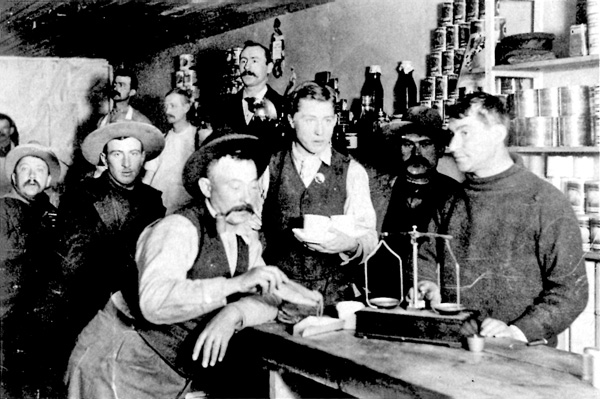
27 Paying with gold dust, probably at one
of Dawson's early restaurants. Note the newspaper wall-covering.
(Public Archives Canada, C 5393.)
|
What form some of the more appetizing of these items
actually took is anyone's guess. One wonders, for instance, whether the
"caviare" was one of the dreadful pastes or tablets which had appeared
in the territory, suitably reconstituted. The stewed fruits were
probably evaporated ones, disguised, and the cold meats were undoubtedly
tinned. What was contained in the "Raw Hamburg steak?" In reporting
this menu, Tappan Adney registers his own doubts about the possibility
of creating these meals from the meagre pile of tins and bottles which
actually appeared on the shelf behind the counter. Eateries of this sort
sprang up across the town. While there are no references to deaths as a
result of their meals, the very experience must have given rise to a
number of unpleasant epithets as alternatives to "Paris of the
North."
Mercantile stability, the first signs of which had
been confirmed that fall by the town's founding father, was not easily
won. In Dawson itself there were tremendous physical obstacles to
overcome before the overgrown mining camp would give way to anything like
"civilization." Problems of health, sanitation, fuel and fresh water
supply, muddy thoroughfares and fire prevention gained increasing
newspaper consideration as winter approached. While the Yukon
Territorial Council was expected to deal with these urban problems, the
responsible merchants were acutely aware of the pressing need for an
active municipal organization. Incorporation of the city of Dawson was
the obvious first proposal, and was initially a popular one among the
city's commercial vested interests.62 Municipal taxation was
a fair price to pay for progress — improvements, protection and an
increased political voice.
The issue was given greater urgency when, in October
1898, a $503,000 fire in Dawson's business section levelled hotels,
saloons, stores and other businesses to frozen rubble.63 The
matter of incorporation would be tossed about for another four years
between Dawson citizens and the Yukon Territorial Council, where the
power to initiate the process resided. The merchants, represented after
August 1899 by the Dawson City Board of Trade,64 would not
always maintain the position on which they had united in the fall of
1898. Throughout these years the topic remained a lively one during the
dark winter days around the Yukon stoves. There it competed with the
gold royalty, freight rates, high prices, land speculation and newly
exchanged gold claims as the basis for opinionated discussion. Dawson
merchants turned their full attention to these concerns, alleviated by
talk about team sports, social functions and newly organized fraternal
orders in the days when the sun barely skimmed the top of the Midnight
Dome, the height of land overlooking Dawson from the east. For most of
the storekeepers who decided to winter inside, 1897-98 had been a
good season. Leather pokes and iron warehouses bulged alike, and there
was an optimism about the place which two major conflagrations could not
destroy.65 As far as anyone knew, the mother lode was still
to be found.
|
 |
 |
|

